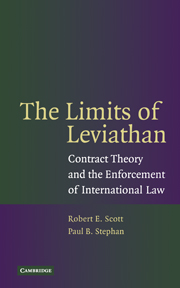Book contents
- Frontmatter
- Contents
- Foreword
- 1 Introduction
- 2 States, Firms, and the Enforcement of International Law
- 3 Lessons from Contract Theory
- 4 A Model of Optimal Enforcement
- 5 Patterns of International Law Enforcement
- 6 The Choice between Formal and Informal Enforcement
- 7 The Future of International Law and Its Enforcement
- Glossary
- Table of Authorities
- Index
7 - The Future of International Law and Its Enforcement
Published online by Cambridge University Press: 29 July 2009
- Frontmatter
- Contents
- Foreword
- 1 Introduction
- 2 States, Firms, and the Enforcement of International Law
- 3 Lessons from Contract Theory
- 4 A Model of Optimal Enforcement
- 5 Patterns of International Law Enforcement
- 6 The Choice between Formal and Informal Enforcement
- 7 The Future of International Law and Its Enforcement
- Glossary
- Table of Authorities
- Index
Summary
There is an elaborate regime of practices and institutions by which the United States and other nations enforce commitments inter sese or decide that, in the national interest, promises given by or to another sovereign should not be enforced in a specific case. Sometimes this is done purely for reasons of prudence, sometimes for convenience, or sometimes to secure advantage in unrelated matters. Incalculable mischief can be wrought by gratuitously introducing into this often delicate process court enforcement at the instigation of private parties. We believe that such a course is to be avoided unless it can be said that private enforcement was clearly agreed to and envisioned by the contracting States in the treaties themselves.
United States v. Li, 206 F. 3rd 56, 68 (1st Cir. 2000) (Seyla & Boudin, JJ., concurring)It may well be useful to have a better understanding of how the enforcement of international law functions in the modern world, but where does that leave us? As scholars, we take some satisfaction in providing an analytically rigorous account of why, across a broad range of subjects and problems, we observe formal enforcement when we do and informal measures elsewhere. But as lawyers, we also feel under an obligation to help the policy maker – judge, legislator, or government official – who must make choices about enforcement strategies. How does contract theory help the international lawmaker?
We must start with an obvious, but perhaps controversial, point.
- Type
- Chapter
- Information
- The Limits of LeviathanContract Theory and the Enforcement of International Law, pp. 180 - 214Publisher: Cambridge University PressPrint publication year: 2006



